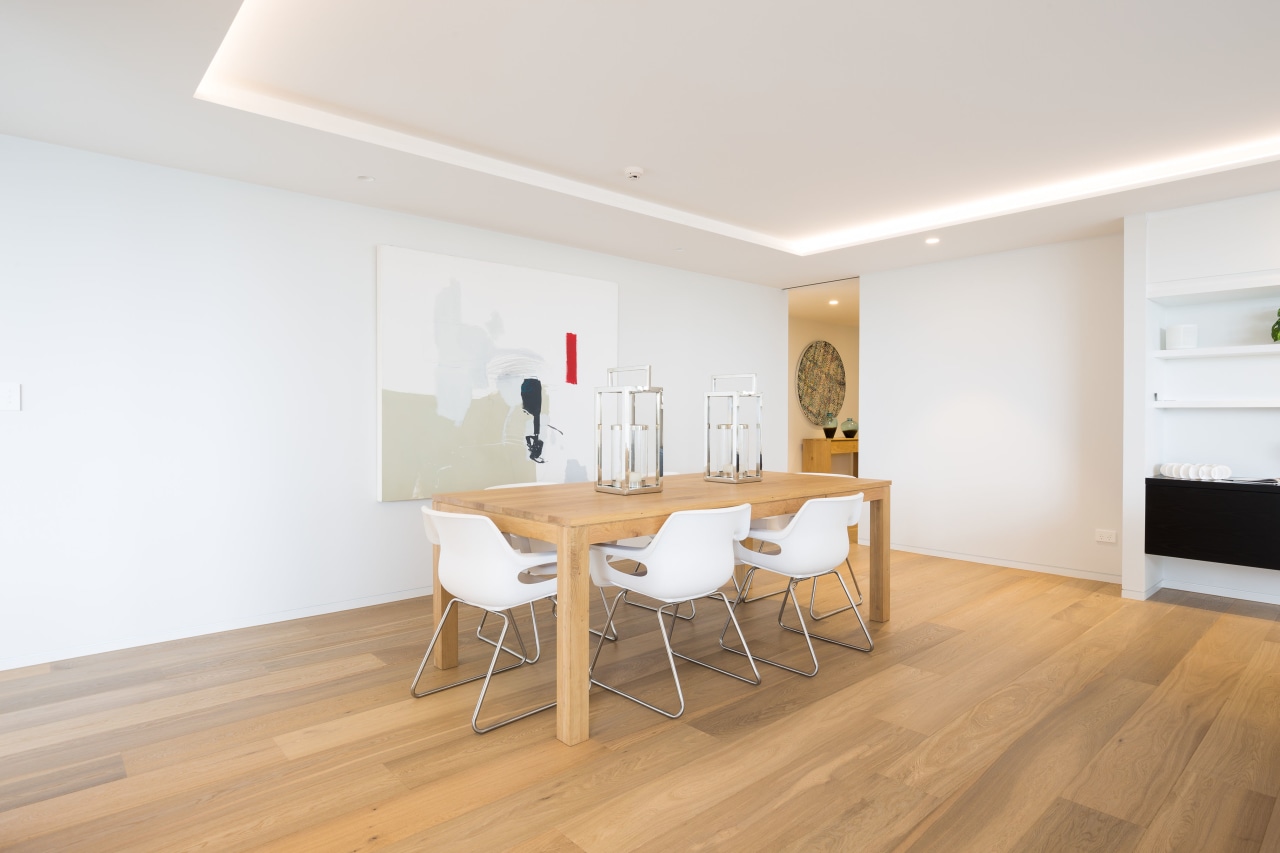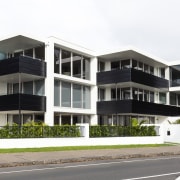Luxury black and white apartments by Julian Guthrie Architecture
High-end Tamaki Drive, Kohimarama, apartments built by Scarbro Residential, with wood floors, Resene surfaces, and Resene Construction System cladding

When you move to a plush new apartment in one of Auckland City's most desirable suburbs, you pretty much expect the best of everything. And when the right architect, constructor, and products are involved, that will be the outcome.
Multi-award winning architectural company Julian Guthrie Architecture designed the luxury apartments 305 Tamaki Drive, Kohimarama, with build and interiors by Scarbro Residential.
Ideally positioned across the road from Kohimarama's sandy beachline, the three apartments feature open, light-filled interiors with stacker sliders opening to spacious decks or patios. There is also a central entrance and feature stair for the upper units, and large basement garages.
Julian Guthrie says the site has a long frontage and the apartments are laid out to maximise the seaviews and to capture the sun.
"The black facade offers a privacy shield and references the local volcanic rock sea wall. White plaster complements the black and is a typical seaside tone, while the use of exposed aggregate also references the sea wall.
"An articulated face breaks up the building's length in visual terms and creates intimate outdoor deck and patio areas."
The solid apartments are in structural steel and precast panel, including precast flooring with a topping slab. Aluminium joinery complements the two-tone facade while the roof is in plywood with a waterproof membrane.
Scarbro undertook the construction of the building, apartment fit-outs, and the finishing, says director at Scarbro Residential Peter Davis.
"Despite the occasional design tweak along the way – the steel staircase was a late inclusion, for example – the construction of the minimalist concrete and steel building went smoothly."
Potentially tricky issues taken in Scarbro's stride included working around an adjacent protected Moreton Bay Fig tree, controlling the water table during the build due to being right next to the waterfront, and installing the structural steel staircase and full-height glazing when the roof was already in place. The heavy staircase would more often have been craned in before the roof was built.

The only other factors were working on the tight site and traffic management due to the high traffic flows and high public interest, with the project being in such a popular location.
"A major advantage for Scarbro is that were able to call on the expertise of the wider Scarbro group of companies to provide support on the more challenging projects," says Davis.
Crisply black, white and minimalist, the building achieves a dramatic street presence.
The exterior had to look fantastic but also perform well in the coastal setting. To meet both factors, the facade is a mix of angle-seam black metal cladding and the contrasting white Resene Construction Systems Masonry Render System.
The Masonry Render System a composite exterior plaster finish was an ideal choice for this upmarket waterfront project, says general manager of Rockcote Resene Mike Olds.
"The system is applied by hand in multiple layers to provide crack resistance, full weather protection and a low upkeep finish. This system also provides peace of mind for the apartment owners as it carries a high 15-year performance Guarantee, as well as a 5-year Workmanship Warranty with a Resene-registered plasterer.
"It also comes complete with our premium Resene Construction Systems EdgeSeal Flashing suite for extra security from water penetration. This is fibreglass reinforced and offers a cost-effective solution with excellent performance."
The Rockcote finishing system also allows the plaster to be pre-coloured from the Resene range.
Inside, the dominant feature is naturally the eye-popping water views, and the open-plan layouts make the most of these. The relaxed, expansive design of the living areas is enhanced by another stand-out feature the refined timber flooring, supplied by Creative Flooring.
Company director Greg Chestnut says one of the developers, Andy Simpson, visited his company's showroom on several occasions to discuss specific colour options.

"Because the flooring is a dominant feature throughout this project, much time was spent deciding on a colour that would ideally suit both the building and its surroundings.
"In the end, we decided on a colour called New Mist however we made a few changes to this at his request. The customisation was viable due to the large volume that was required.
"The final specification was Euro Oak Plank in the dimensions of 220mm x 1900mm x 15mm with a 4mm top of solid oak. The pale New Mist colour is lightly brushed with a Matt Lacquer finish," says Chestnut.
In addition, Creative Flooring is committed to sustainability, and this flooring reflects this.
While the floors are beautiful, their tone is relatively understated allowing the setting to take centre stage. And the same applies to the subtle Resene wall and ceiling finishes.
The Tamaki Drive apartments feature walls in Resene Wan White a warm white that's warmer than grey, from the Resene Karen Walker Paints collection. The Resene Zylone Sheen surface helps avoid glare in the units and is easy to maintain.
The apartment walls are matched with doors in Resene Enamacryl gloss. This is a new-generation product that offers durable, enamel-like finishes with all the benefits of waterborne paints non yellowing, low odour and clean up in water.
Resene Alabaster, also from the Resene Whites & Neutrals collection, was specified on the ceilings. This is a near white surface with a light blackened edge, says Karen Warman for Resene.
"Choosing popular ceiling and wall colours like these creates a subtle look that ideally complements the minimalist feel of these plush harbourside apartments."
Credit list
Resene website
Scarbro Residential
Resene phone
Creative Flooring
Rockcote
Story by: Trendsideas
Home kitchen bathroom commercial design
Home Trends Vol. 32/3
Bathrooms take centre stage in this latest edition of myTrends HOME – from an expansive master suite with spectacular de...
Read More






